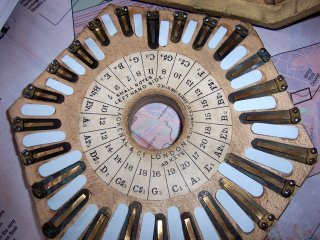
Well, the incredible humidity in the north... or should I say the incredible lack of humidity... finally got to my little concertina. The action board, where the keys are sprung and the holes are drilled for the reeds, dryed out and cracked and warped and the poor little thing needed some emergency repairs.... I'd heard the problem developing earlier so I ordered Dave Elliot's repair guide, and happily the tools necessary were all contained within my trusty swiss army knife (Thanks, Peter). So following his advice I got some PVA wood glue and I took the the little thing apart to get to the inner workings...

That's the action board removed and the inside of the bellows and the reed pan... and there are the little white dots between the holes where I patched up the cracks... with the cardboard from one of Barclay's biscuit boxes (thanks, Barclay)...
So the little thing has most of it's tone back. I have to do one more repair on a spring on one of the keys that seems to be stuck. Now it lives in the bathroom with the humidifier on it at all times... it seems happier. It's such an odd little instrument... I'll paste a short history below..

At the beginning of the nineteenth century, a new group of musical instruments arose in
By the early years of the twentieth century, the concertina's popularity had broadened, giving rise to the working class concertina bands of England's northern mill towns, and the instrument also found a niche as a populist addition to the instrumentation of the Salvation Army band.

1 comment:
very cool piece you've got there Brem. I like how beautifully you tip your hat to the past.
Post a Comment